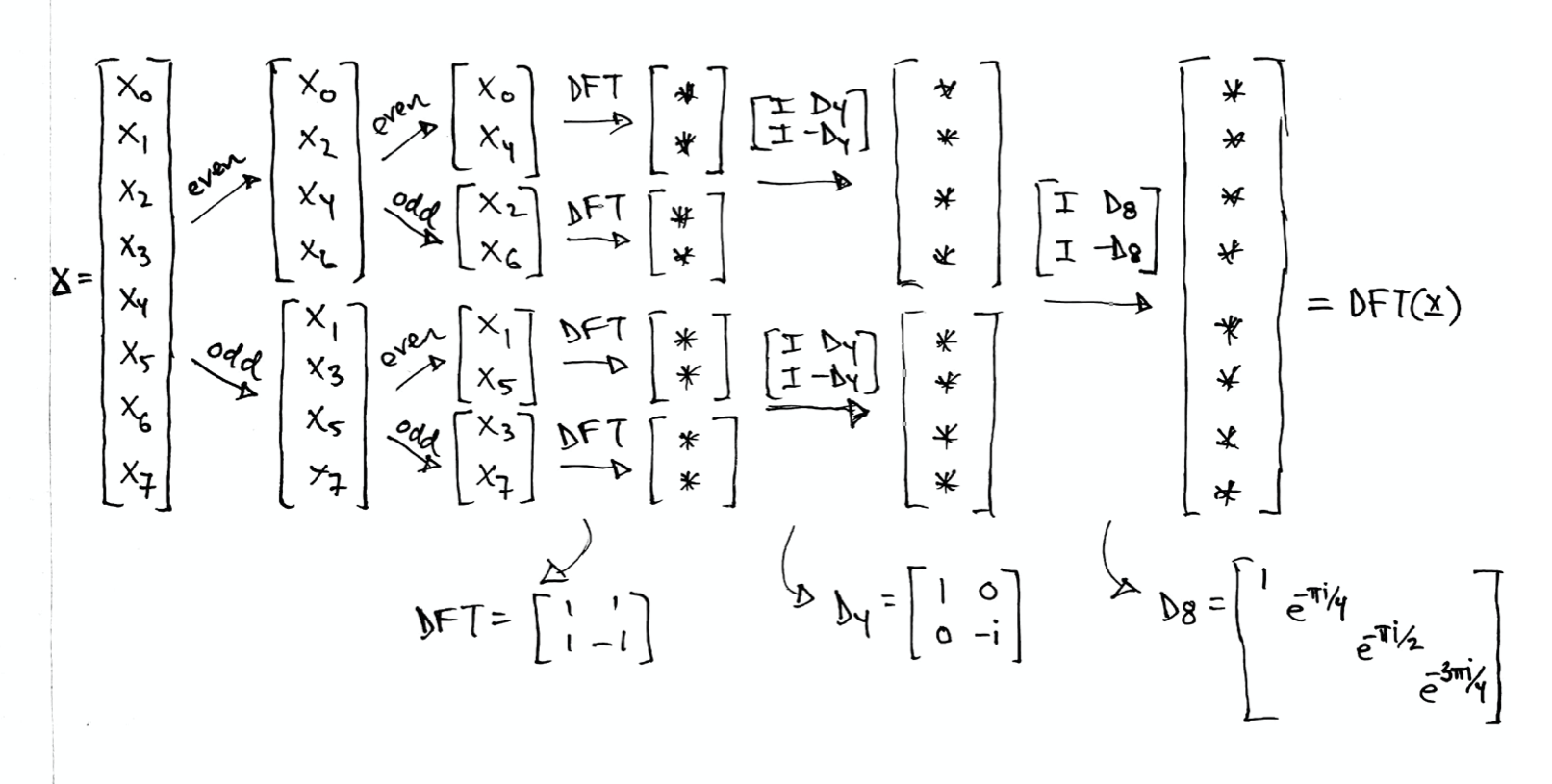Let \(\boldsymbol{x} \in \mathbb{C}^N\) be a signal of length \(N\) (and assume \(N\) is even). Then
\[\begin{split}
\mathrm{DFT}(\boldsymbol{x}) =
\renewcommand{\arraystretch}{1.25}
\left[ \begin{array}{c}
\mathrm{DFT}(\boldsymbol{x}_{\text{even}}) + D_N \mathrm{DFT}(\boldsymbol{x}_{\text{odd}}) \\
\mathrm{DFT}(\boldsymbol{x}_{\text{even}}) - D_N \mathrm{DFT}(\boldsymbol{x}_{\text{odd}})
\end{array} \right]
=
\left[ \begin{array}{rr} I & D_N \\ I & - D_N \end{array} \right]
\left[ \begin{array}{l}
\mathrm{DFT}(\boldsymbol{x}_{\text{even}}) \\
\mathrm{DFT}(\boldsymbol{x}_{\text{odd}})
\end{array} \right]
\renewcommand{\arraystretch}{1}
\end{split}\]
where \(\boldsymbol{x}_{\text{even}}\) and \(\boldsymbol{x}_{\text{odd}}\) are vectors of length \(N/2\) consisting of the even and odd indices respectively
\[\begin{split}
\boldsymbol{x}_{\text{even}} = \begin{bmatrix} x_0 \\ x_2 \\ \vdots \\ x_{N-2} \end{bmatrix}
\hspace{10mm}
\boldsymbol{x}_{\text{odd}} = \begin{bmatrix} x_1 \\ x_3 \\ \vdots \\ x_{N-1} \end{bmatrix}
\end{split}\]
and
\[\begin{split}
D_N = \begin{bmatrix} 1 & & & \\ & \omega_N^{-1} & & \\ & & \ddots & \\ & & & \omega_N^{-(N/2-1)} \end{bmatrix}
\end{split}\]
Proof. Let \(\boldsymbol{y} = \mathrm{DFT}(\boldsymbol{x})\), look at the \(k\)th entry of \(\boldsymbol{y}\) and split the sum into the even and odd terms
\[\begin{split}
\begin{align*}
\boldsymbol{y}[k] &= \langle \boldsymbol{x} , \boldsymbol{f}_k \rangle = \sum_{n=0}^{N-1} x_n \omega_N^{-nk} \\
&= \sum_{m=0}^{N/2-1} x_{2m} \omega_N^{-2mk} + \sum_{m=0}^{N/2-1} x_{2m + 1} \omega_N^{-(2m + 1)k}
\end{align*}
\end{split}\]
See that \(\omega_N^2 = e^{(2 \pi i / N)2} = e^{2 \pi i / (N/2)} = \omega_{N/2}\) and write
\[
\boldsymbol{y}[k]= \sum_{m=0}^{N/2-1} x_{2m} \omega_{N/2}^{-mk} + \omega_N^{-k} \sum_{m=0}^{N/2-1} x_{2m + 1} \omega_{N/2}^{-mk}
\]
For \(0 \leq k < N/2\), these are the formulas for DFT of vectors of length \(N/2\) consisting of the even and odd indices respectively
\[\begin{split}
\boldsymbol{x}_{\text{even}} = \begin{bmatrix} x_0 \\ x_2 \\ \vdots \\ x_{N-2} \end{bmatrix}
\hspace{10mm}
\boldsymbol{x}_{\text{odd}} = \begin{bmatrix} x_1 \\ x_3 \\ \vdots \\ x_{N-1} \end{bmatrix}
\end{split}\]
Note that
\[\begin{split}
\begin{align*}
\boldsymbol{y}[k + N/2] &= \sum_{m=0}^{N/2-1} x_{2m} \omega_{N/2}^{-m(k + N/2)} + \omega_N^{-(k+N/2)} \sum_{m=0}^{N/2-1} x_{2m + 1} \omega_{N/2}^{-m(k + N/2)} \\
&= \sum_{m=0}^{N/2-1} x_{2m} \omega_{N/2}^{-mk} \underbrace{\omega_{N/2}^{-mN/2}}_{1} + \omega_N^{-k} \underbrace{\omega_N^{-N/2}}_{-1} \sum_{m=0}^{N/2-1} x_{2m + 1} \omega_{N/2}^{-mk} \underbrace{\omega_{N/2}^{-mN/2}}_{1} \\
&= \sum_{m=0}^{N/2-1} x_{2m} \omega_{N/2}^{-mk} - \omega_N^{-k} \sum_{m=0}^{N/2-1} x_{2m + 1} \omega_{N/2}^{-mk}
\end{align*}
\end{split}\]
which again are the DFTs of the even and odd parts of \(\boldsymbol{x}\). Put these formulas for \(\boldsymbol{y}\) together to get
\[\begin{split}
\boldsymbol{y} = \mathrm{DFT}(\boldsymbol{x}) =
\renewcommand{\arraystretch}{1.25}
\left[ \begin{array}{c}
\mathrm{DFT}(\boldsymbol{x}_{\text{even}}) + D_N \mathrm{DFT}(\boldsymbol{x}_{\text{odd}}) \\
\mathrm{DFT}(\boldsymbol{x}_{\text{even}}) - D_N \mathrm{DFT}(\boldsymbol{x}_{\text{odd}})
\end{array} \right]
\renewcommand{\arraystretch}{1}
\end{split}\]
where
\[\begin{split}
D_N = \begin{bmatrix} 1 & & & \\ & \omega_N^{-1} & & \\ & & \ddots & \\ & & & \omega_N^{-(N/2-1)} \end{bmatrix}
\end{split}\]
Use the FFT to compute the DFT of the signal
\[\begin{split}
\boldsymbol{x} = \left[ \begin{array}{r} 1 \\ 1 \\ 1 \\ 1 \\ -1 \\ -1 \\ -1 \\ -1 \end{array} \right]
\end{split}\]
The symmetry in the signal reduces the number of computations even further
\[\begin{split}
\begin{array}{cc}
\begin{array}{c}
\begin{bmatrix} x_0 \\ x_4 \end{bmatrix} = \left[ \begin{array}{r} 1 \\ -1 \end{array} \right] \stackrel{\mathrm{DFT}}{\longrightarrow} \left[ \begin{array}{r} 0 \\ 2 \end{array} \right]
\\
\begin{bmatrix} x_2 \\ x_6 \end{bmatrix} = \left[ \begin{array}{r} 1 \\ -1 \end{array} \right] \stackrel{\mathrm{DFT}}{\longrightarrow} \left[ \begin{array}{r} 0 \\ 2 \end{array} \right]
\end{array}
&
\longrightarrow
\left[ \begin{array}{c}
\left[ \begin{array}{r} 0 \\ 2 \end{array} \right] + \left[ \begin{array}{rr} 1 & \\ & -i \end{array} \right] \left[ \begin{array}{r} 0 \\ 2 \end{array} \right]
\\
\left[ \begin{array}{r} 0 \\ 2 \end{array} \right] - \left[ \begin{array}{rr} 1 & \\ & -i \end{array} \right] \left[ \begin{array}{r} 0 \\ 2 \end{array} \right]
\end{array} \right]
=
\left[ \begin{array}{c} 0 \\ 2-2i \\ 0 \\ 2+2i \end{array} \right]
\\
\begin{array}{c}
\begin{bmatrix} x_1 \\ x_5 \end{bmatrix} = \left[ \begin{array}{r} 1 \\ -1 \end{array} \right] \stackrel{\mathrm{DFT}}{\longrightarrow} \left[ \begin{array}{r} 0 \\ 2 \end{array} \right]
\\
\begin{bmatrix} x_3 \\ x_7 \end{bmatrix} = \left[ \begin{array}{r} 1 \\ -1 \end{array} \right] \stackrel{\mathrm{DFT}}{\longrightarrow} \left[ \begin{array}{r} 0 \\ 2 \end{array} \right]
\end{array}
&
\longrightarrow
\left[ \begin{array}{c}
\left[ \begin{array}{r} 0 \\ 2 \end{array} \right] + \left[ \begin{array}{rr} 1 & \\ & -i \end{array} \right] \left[ \begin{array}{r} 0 \\ 2 \end{array} \right]
\\
\left[ \begin{array}{r} 0 \\ 2 \end{array} \right] - \left[ \begin{array}{rr} 1 & \\ & -i \end{array} \right] \left[ \begin{array}{r} 0 \\ 2 \end{array} \right]
\end{array} \right]
=
\left[ \begin{array}{c} 0 \\ 2-2i \\ 0 \\ 2+2i \end{array} \right]
\end{array}
\end{split}\]
We can write the matrix \(D_8\) as
\[\begin{split}
D_8 = \left[ \begin{array}{rrrr} 1 & & & \\ & e^{- \pi i /4} & & \\ & & e^{- \pi i /2} & \\ & & & e^{- 3\pi i /4} \end{array} \right]
= \left[ \begin{array}{rrrr} 1 & & & \\ & \frac{1-i}{\sqrt{2}} & & \\ & & -i & \\ & & & \frac{-1-i}{\sqrt{2}} \end{array} \right]
\end{split}\]
and then compute
\[\begin{split}
\mathrm{DFT}(\boldsymbol{x}) =
\left[
\begin{array}{c}
\left[ \begin{array}{c} 0 \\ 2-2i \\ 0 \\ 2+2i \end{array} \right]
+
\left[ \begin{array}{rrrr} 1 & & & \\ & \frac{1-i}{\sqrt{2}} & & \\ & & -i & \\ & & & \frac{-1-i}{\sqrt{2}} \end{array} \right]
\left[ \begin{array}{c} 0 \\ 2-2i \\ 0 \\ 2+2i \end{array} \right]
\\
\left[ \begin{array}{c} 0 \\ 2-2i \\ 0 \\ 2+2i \end{array} \right]
-
\left[ \begin{array}{rrrr} 1 & & & \\ & \frac{1-i}{\sqrt{2}} & & \\ & & -i & \\ & & & \frac{-1-i}{\sqrt{2}} \end{array} \right]
\left[ \begin{array}{c} 0 \\ 2-2i \\ 0 \\ 2+2i \end{array} \right]
\end{array}
\right]
=
\left[ \begin{array}{c} 0 \\ 2 - 2 \left( \sqrt{2} + 1 \right) i \\ 0 \\ 2 - 2 \left( \sqrt{2} - 1 \right) i \\ 0 \\ 2 + 2 \left( \sqrt{2} - 1 \right) i \\ 0 \\ 2 + 2 \left( \sqrt{2} + 1 \right) i \end{array} \right]
\end{split}\]

